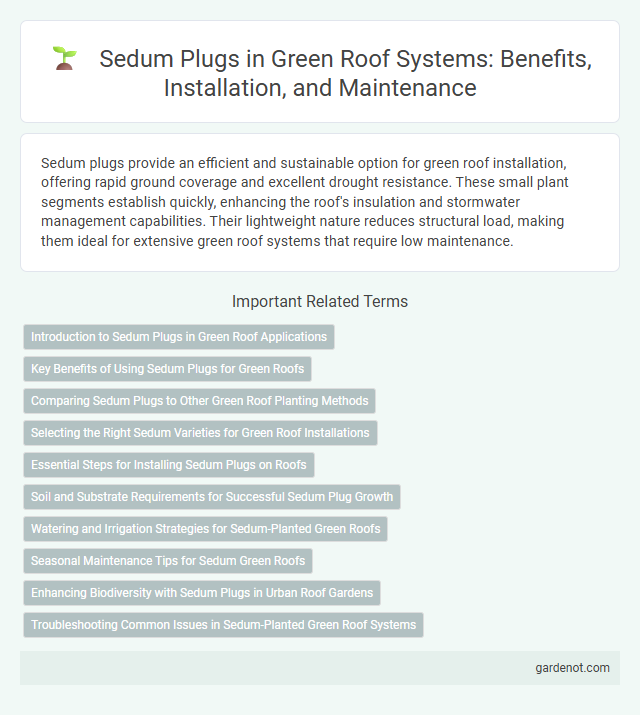Sedum plugs provide an efficient and sustainable option for green roof installation, offering rapid ground coverage and excellent drought resistance. These small plant segments establish quickly, enhancing the roof's insulation and stormwater management capabilities. Their lightweight nature reduces structural load, making them ideal for extensive green roof systems that require low maintenance.
Introduction to Sedum Plugs in Green Roof Applications
Sedum plugs are small, pre-grown clusters of sedum plants used extensively in green roof installations due to their drought tolerance and low maintenance requirements. These plugs offer rapid ground coverage, enhancing the green roof's insulation properties and stormwater retention capabilities. Their adaptability to harsh rooftop conditions makes them a preferred choice for sustainable urban landscaping solutions.
Key Benefits of Using Sedum Plugs for Green Roofs
Sedum plugs offer exceptional drought tolerance and low maintenance requirements, making them ideal for green roofs in various climates. Their extensive root systems enhance soil stability and promote water retention, contributing to improved stormwater management and reduced runoff. These plugs also provide rapid ground coverage, increasing thermal insulation and supporting urban biodiversity by attracting pollinators.
Comparing Sedum Plugs to Other Green Roof Planting Methods
Sedum plugs offer superior establishment speed and lower maintenance compared to sedum mats and seed mixtures on green roofs. Their dense root systems enhance substrate stabilization and water retention, outperforming seedlings in drought resilience and erosion control. Cost-effectiveness and ease of installation make sedum plugs a preferred method for sustainable green roofing projects.
Selecting the Right Sedum Varieties for Green Roof Installations
Choosing the right Sedum varieties for green roof installations is crucial for ensuring drought tolerance, low maintenance, and climate adaptability. Varieties like Sedum album, Sedum spurium, and Sedum acre thrive in shallow substrates, providing excellent ground cover and erosion control. Selecting species with diverse flowering times enhances biodiversity and visual appeal throughout the growing season.
Essential Steps for Installing Sedum Plugs on Roofs
Installing Sedum plugs on green roofs requires careful substrate preparation, ensuring a well-draining growing medium with adequate depth, typically 2 to 3 inches, to support root development. Proper spacing, usually 6 to 12 inches apart, allows plugs to expand and create a dense vegetative cover, while consistent watering during the establishment phase promotes healthy growth and plug survival. Securing plugs with lightweight mulch or biodegradable mats prevents displacement from wind or rain, enhancing long-term vegetation success on rooftop environments.
Soil and Substrate Requirements for Successful Sedum Plug Growth
Sedum plug cultivation requires well-draining, nutrient-rich soil with a balanced pH between 6.0 and 7.5 to promote healthy root development on green roofs. The substrate should have a lightweight composition, often incorporating components like expanded shale or pumice, to prevent waterlogging and ensure adequate aeration. Optimizing moisture retention while maintaining proper drainage supports robust Sedum plug growth and long-term sustainability.
Watering and Irrigation Strategies for Sedum-Planted Green Roofs
Sedum plugs, known for their drought tolerance, require minimal watering once established, but initial irrigation is crucial to ensure root development on green roofs. Implementing a drip irrigation system tailored to the substrate's moisture level can optimize water use and promote healthy Sedum growth while preventing overwatering. Regular monitoring of soil moisture sensors helps maintain ideal hydration, enhancing the green roof's overall resilience and longevity.
Seasonal Maintenance Tips for Sedum Green Roofs
Sedum plugs on green roofs require seasonal maintenance to ensure healthy growth and longevity. During spring, inspect for any winter damage and remove debris to promote new shoots, while summer demands regular watering especially during dry spells to prevent drought stress. In fall, trim back overgrowth and clear fallen leaves to maintain optimal photosynthesis and prevent fungal diseases.
Enhancing Biodiversity with Sedum Plugs in Urban Roof Gardens
Sedum plugs significantly enhance biodiversity in urban roof gardens by providing a habitat for pollinators such as bees and butterflies. Their drought-resistant nature and low maintenance requirements make them ideal for sustainable green roofs, supporting diverse micro-ecosystems. Integrating sedum plugs into urban green spaces improves air quality and promotes ecological balance in densely populated areas.
Troubleshooting Common Issues in Sedum-Planted Green Roof Systems
Sedum plugs in green roof systems often face issues like poor establishment due to inadequate watering and soil compaction, which restrict root growth and nutrient uptake. To troubleshoot these problems, ensure proper irrigation schedules and use lightweight, well-draining growing media to promote healthy root development. Monitoring for pests such as aphids and managing extreme weather exposure with protective coverings can also enhance Sedum survival and performance.
Sedum plug Infographic

 gardenot.com
gardenot.com